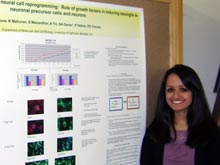Jillian Lee Silvestrini

I am studying the possible physical or functional interaction between ELF3 and CRY2, two genes in Arabidopsis thaliana that are involved in regulating the plants biological clock. I will study ELF3 and CRY2 using Arabidopsis plants that have mutations in these genes, resulting in dysfunctional proteins. Many of the phenotypes of the single mutants are opposite, which helps to facilitate analysis of the gene interaction. I will look at flowering time, monochromatic and white light signaling (using hypocotyl elongation as an assay), and regulation of 24-hour rhythms using Luciferase as […]
Huiyi Chen
Felice Lin
An alarming number of methicillin-resistant Staphylococcus aureus infections have begun to surface in communities due to a particular strain USA300. USA300 carries a single conjugative plasmid, pUSA03, which confers multiple antibiotic resistance. This is of great concern because the plasmid has been suggested to be able to acquire additional resistance genes in response to changing antibiotic uses. To study the evolution of pUSA03, I hope to characterize the pUSA03 plasmid found in USA300 isolates infecting patients by whole plasmid PCR scanning that could detect any structural changes in the plasmid […]
Chen Chen

One of the most surprising conclusions to emerge from whole genome sequencing projects in the last decade is that all animals have roughly the same number of genes. Initially, this seems contradictory to the idea that higher organisms have more genes to account for higher levels of complexity. However, one potential explanation is alternative pre-mRNA splicing, through which different exon combinations are incorporated into mature transcripts, thereby increasing the number of proteins encoded by a limited number of genes. Although there have been extensive studies in vitro concerning the biochemical […]
Vibha Mahendra

The human lens is made up of two types of cells: a monolayer of lens epithelial cells, and its differentiated progeny, lens fiber cells. The differentiation process is a complex sequence of events in which lens epithelial cells slowly lose all their organelles, and elongate into lens fiber cells. There is a lens membrane protein called Lim2 that appears to exist only in lens fiber cells, and not in lens epithelial cells. Lim2 is known to be critically important for maintaining the integrity of the lens, and its role will […]
Sarah Soliman

In adult animals, many tissues undergo continuous renewal, a process in which older cells die and are replaced by newly born cells. These new cells are generated by the proliferation of tissue stem cells, which divide continuously throughout the animal’s lifetime. The process of tissue self-renewal has long been thought essential for the maintenance of tissue structure and function; however, this presumption has never been explicitly examined. In my SURF project, I will explore the necessity of tissue renewal using the Drosophila epithelial midgut as a model system. Specifically, my […]
Punam Bhullar
Julia Selezneva
The core goal is to identify the origin of antibiotic drug-resistance determinants, with the hypothesis that drug-resistance determinants, in particular integrons carrying gene cassettes coding for drug resistance, from bacteria that is ingested through uncooked food (spinach, animal meat) can horizontally transfer to commensal bacteria in the human intestine, and under selective pressure of antibiotics, and ultimately lead to complicated multi-drug resistant bloodstream or urinary tract infections. Integrons are mobile genetic elements, found on transposons, plasmids and chromosomes that capture and express gene cassettes by site-specific recombination. This summer I […]
Chung Yan Cheung

Development of the nervous system depends on the migration, differentiation, and axonal projections of neurons to their appropriate targets. In the dorsal spinal cord where many sensory and interneurons are born, signaling cues specify the development of neuronal precursors into an array of cell types. However, the process by which these signals regulate neuronal growth is still unclear. This summer, I will examine the function of the Gremlin2 gene, which is expressed in a specific population of dorsal interneurons. Taking advantage of Gremlin2 knock-out mice, I will use immunocytochemistry to […]
Shila Manandhar

Neurogenesis, the process by which new neurons form, was thought to be impossible in mature brains for most of the 20th century. However, recent studies have found that neurogenesis in intact adult brains does occur in specific regions. I will be studying neurogenesis in vitro using neuroglial cells, which are neuron supporting cells, by treating them with Epidermal Growth Factor (EGF) and Fibroblast Growth Factor (FGF). Following treatment, I will perform functional tests to evaluate the extent to which these factors were able to promote the transdifferentiation of these neuroglial […]